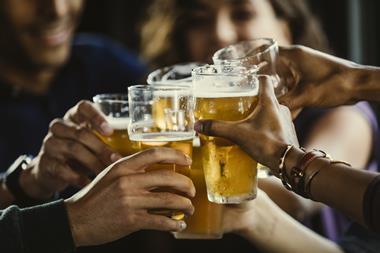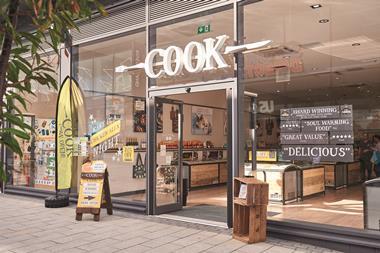Christmas is a time for celebration - and it’s the biggest sales period of the year for suppliers and retailers. Sonya Hook and Claire Hu report
Christmas is the season to be jolly, especially in the drinks business. The annual war of words between suppliers and retailers over discounting can often cloud the fact that it’s the biggest sales period of the year for both sides.
While brand owners are keen to see value added back to their respective categories, price discounting on alcohol cannot be avoided as it’s a key footfall driver in the multiples.
Diageo’s off-trade MD, Benet Slay, says buyers certainly expect prices to go lower this Christmas. “There will be a lot of pressure. But for consumers, whose primary goal is to host a perfect Christmas, value is not the key thing. Price is only a small part of the mix.”
Cider brands are particularly hopeful that a resurgence of consumer interest will help hold up prices this Christmas. Value has outgrown volume increases for Scottish Courage’s market leading Strongbow brand as well as its leading premium cider Scrumpy Jack.
Keith Hogg, ScotCo’s group sales director, says the company will drop all extra-free deals on Strongbow, Woodpecker and Scrumpy Jack early next year. “We think our customers can make more money in cider this Christmas. There isn’t usually such a big sales peak as for beer, but it is a profitable peak.”
Meanwhile, beer discounting is expected to be as aggressive as last year, but many hope that prices won’t drop further. Neil Jardine, take-home director at Greene King Brewing Company, says: “We have no reason to believe Christmas pricing will be at any reduced level compared with last year.”
Leading brewers warn that discounting mechanics such as two cases for £20 will appear again but some, including InBev UK, are still doing deals on 20 rather than 24-packs. Stuart MacFarlane, MD of take-home at InBev UK, says: “The broad spread of brands in last year’s ‘two for £20’ case deals created confusion among consumers, and the scattergun approach certainly didn’t deliver the best value for retailers or suppliers.”
MacFarlane believes the
industry would benefit from promoting not just the big brands but those able to deliver in terms of price. He points to what he claims was a significant difference in the price of Carlsberg and Stella Artois last Christmas.
Carlsberg has, however, been a leading contender in the off-trade. Its volume and value sales have gone up this year with 56.9% value growth [ACNielsen, MAT April 16, 2005].
Meanwhile, Kevin Brownsey, off-trade sales director at Coors Brewers, claims Carling has been among the few brands to show value growth.
Of the other drinks categories, the strong players in the ready-to-drink market have expressed confidence in the future of their brands, despite the category continuing to plummet, but pricing over Christmas is an ongoing bugbear. The top seven brands are all in decline, although Beverage Brands’ WKD brand is down only 2% on last year [ACNielsen MAT August 6, 2005], moving it up to second place, and Diageo’s Smirnoff Ice, the number one take-home RTD brand, has extended its lead over Bacardi Breezer, despite seeing a decline of 9.5% on last year.
Christmas is a time when indulgent products are high on many shopping
lists, and spirit and fortified wine producers rely heavily on the season to achieve a large proportion of their sales. “Price discounting on spirits at Christmas is important to drive demand, but balancing this and driving value is tricky,” says John Grieveson, head of marketing at Pernod Ricard, owner of brands such as Martell Cognac and Havana Club. “We do this with things such as gift packs, as well as price discounts of the more premium versions to get people to trade up.”
While the multiples are likely to dominate Christmas sales, MacFarlane believes there will be an increase in competitive activity from specialist off-licence and convenience chains.
Christmas is the season to be jolly, especially in the drinks business. The annual war of words between suppliers and retailers over discounting can often cloud the fact that it’s the biggest sales period of the year for both sides.
While brand owners are keen to see value added back to their respective categories, price discounting on alcohol cannot be avoided as it’s a key footfall driver in the multiples.
Diageo’s off-trade MD, Benet Slay, says buyers certainly expect prices to go lower this Christmas. “There will be a lot of pressure. But for consumers, whose primary goal is to host a perfect Christmas, value is not the key thing. Price is only a small part of the mix.”
Cider brands are particularly hopeful that a resurgence of consumer interest will help hold up prices this Christmas. Value has outgrown volume increases for Scottish Courage’s market leading Strongbow brand as well as its leading premium cider Scrumpy Jack.
Keith Hogg, ScotCo’s group sales director, says the company will drop all extra-free deals on Strongbow, Woodpecker and Scrumpy Jack early next year. “We think our customers can make more money in cider this Christmas. There isn’t usually such a big sales peak as for beer, but it is a profitable peak.”
Meanwhile, beer discounting is expected to be as aggressive as last year, but many hope that prices won’t drop further. Neil Jardine, take-home director at Greene King Brewing Company, says: “We have no reason to believe Christmas pricing will be at any reduced level compared with last year.”
Leading brewers warn that discounting mechanics such as two cases for £20 will appear again but some, including InBev UK, are still doing deals on 20 rather than 24-packs. Stuart MacFarlane, MD of take-home at InBev UK, says: “The broad spread of brands in last year’s ‘two for £20’ case deals created confusion among consumers, and the scattergun approach certainly didn’t deliver the best value for retailers or suppliers.”
MacFarlane believes the
industry would benefit from promoting not just the big brands but those able to deliver in terms of price. He points to what he claims was a significant difference in the price of Carlsberg and Stella Artois last Christmas.
Carlsberg has, however, been a leading contender in the off-trade. Its volume and value sales have gone up this year with 56.9% value growth [ACNielsen, MAT April 16, 2005].
Meanwhile, Kevin Brownsey, off-trade sales director at Coors Brewers, claims Carling has been among the few brands to show value growth.
Of the other drinks categories, the strong players in the ready-to-drink market have expressed confidence in the future of their brands, despite the category continuing to plummet, but pricing over Christmas is an ongoing bugbear. The top seven brands are all in decline, although Beverage Brands’ WKD brand is down only 2% on last year [ACNielsen MAT August 6, 2005], moving it up to second place, and Diageo’s Smirnoff Ice, the number one take-home RTD brand, has extended its lead over Bacardi Breezer, despite seeing a decline of 9.5% on last year.
Christmas is a time when indulgent products are high on many shopping
lists, and spirit and fortified wine producers rely heavily on the season to achieve a large proportion of their sales. “Price discounting on spirits at Christmas is important to drive demand, but balancing this and driving value is tricky,” says John Grieveson, head of marketing at Pernod Ricard, owner of brands such as Martell Cognac and Havana Club. “We do this with things such as gift packs, as well as price discounts of the more premium versions to get people to trade up.”
While the multiples are likely to dominate Christmas sales, MacFarlane believes there will be an increase in competitive activity from specialist off-licence and convenience chains.














No comments yet